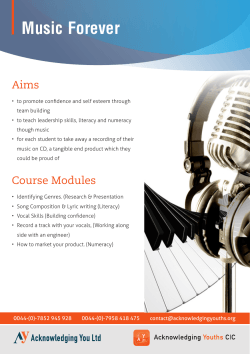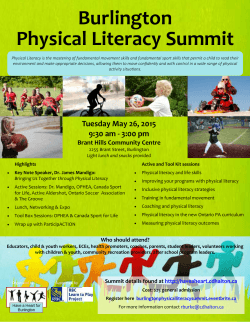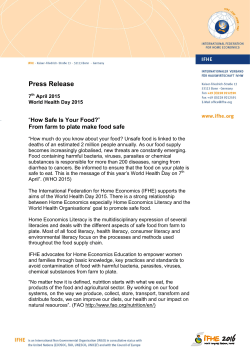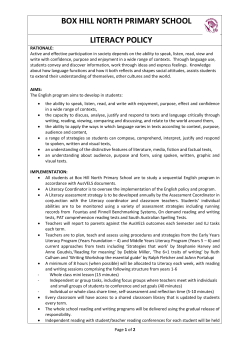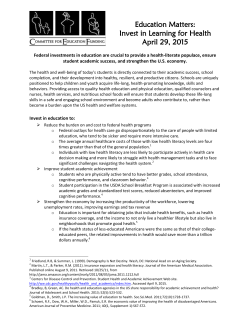
Developing an understanding of the link between
Module 5 Developing an understanding of the link between metacognition and the acquisition of higherorder literacy skills 1 Module aims • To develop understanding of the link between metacognition and the acquisition of higherorder literacy skills. • To consider PISA’s role in developing pedagogy that improves learning and teaching. 2 Module objectives • Review some key aspects of metacognition. • Establish links between metacognition, higherorder literacy skills, PISA testing and effective classroom practice. • Consider the possible educational benefits of using metacognition as an essential tool in the development of higher-order literacy in twentyfirst century classrooms. • Examine the extent to which nurturing higherorder thinking skills with higher-order literacy skills leads to greater success in PISA tests and improved quality in learning and teaching. 3 Thinking about thinking Unlike cognition, which is merely the act of knowing, metacognition is the learner’s reflection about what he or she already knows or is in the process of learning. (Smith, 2004) 4 Thinking about thinking This use of metacognition is essential to ensure effective development of higherorder literacy in twenty-first century classrooms and create new thinkers for the future. 5 Metacognition and able learners Higher order thinking does not necessarily show itself in evidence of 'quick thinking', but in their ability to use quick or slow thinking when the occasion demands. (Davison, Deuser and Sternberg, 1996) 6 To transcend cognition • The term metacognition was introduced by Flavell in 1976 to refer to 'the individual's own awareness and consideration of his or her cognitive processes and strategies' (Flavell 1979). • It refers to that uniquely human capacity of people to be self-reflexive, not just to think and know but to think about their own thinking and knowing. 7 PISA and metacognitive approaches Reading literacy as measured in PISA requires learners to demonstrate their skills in dealing with a wide range of texts, drawn from different situations and approached from a number of perspectives. 8 PISA and metacognitive approaches • The Reading for Change report (OECD, 2001) focuses on two text formats: – continuous – non continuous) • and three approaches to reading: – retrieving information – interpreting – reflecting. • In 2013 these remain the core aspects tested by PISA. 9 Task 1: PISA reading question 10 Task 1 What feature of the movies caused the people of Macondo to become angry? OECD, 2009 11 Approaching the question • Explain the approach you made to answering the PISA reading question. • How did you access the text? – Read it through. – Skim the text. – Re-read the text. – Identify key words. – Identify key themes. • Where did you begin reading? OECD, 2009 12 Higher-order literacy • Effective reading is concerned with a search for meaning within an increasingly challenging range of texts. Learners need to be aware that their reading may serve a range of purposes, including for pleasure, information and instruction. 13 Higher-order literacy • Effective writing is concerned with expressing information, ideas, thoughts and emotions with clarity, coherence and fluency in a wide range of forms and styles. It is adapted to suit its audience and purpose and is accurate in terms of spelling, punctuation and grammar. 14 Higher-order literacy skills • An important step towards achieving higherorder literacy skills is higher-order speaking and listening through which learners can: – discuss what they have read and come to a full understanding of a text – rehearse and refine ideas before they write – make use of assessment for learning techniques which require them to evaluate their own and each other’s work and to make suggestions for improvement. 15 Task 2: Metacognition and higher-order literacy skills 16 Which metacognative skills did you use? Critical thinking n o i s i c De making Prioritising Questio Making connections g n i n n a l P Visual memory Meta memory Applying Setting targets Reflection ni ng Solving Comm u ni ca t i on Problemsolving 17 Which of the higher-order literacy skills did you use? Reading Reviewing Exploring / Organising vocabulary g n i s i n a g r o re Recognising multiple levels of meaning Collating Locating n i c n e u q e S Summarising g n i n n a Sc Absorbi ng informa ti o n Decoding g Writin g Comparing 18 Overlapping skills? Meta memory Locating Writing Metacognition skills Higher-order literacy skills 19 An ability to use knowledge and skills In 2013, PISA conceives of literacy as the capacity of students to apply knowledge and skills in key subject areas and to analyse, reason and communicate effectively as they pose, solve and interpret problems in a variety of situations. PISA is forward looking, focusing on young people’s ability to use their knowledge and skills to meet real-life challenges, rather than merely on the extent to which they have mastered specific curricular content. (OECD, 2010) 20 Plenary: Using PISA materials in the classroom In pairs, discuss: • the type of text and the higher-order skills which the ‘Macondo’ task teaches and assesses • the prior knowledge and elements of metacognition that would have prepared a learner for such a task • whether or not you teach these skills in your classroom • to what extent the task suits a twenty-first century learner. 21 Task 3: Audit of practice 22 The whole-school approach Watch the video clip where a teacher discusses his experience of using metacognition and thinking skills in the classroom. • Identify an element of practice that you would like to explore further. 23 http://www.youtube.com/watch?v=qDUyWAdTiq4 24 Higher-order literacy: audit of classroom practice • Using the audit sheets provided, indicate which aspects of higher-order reading and/or writing have been carried out in your classroom this week. 25 Higher-order literacy: audit of classroom practice • Work in pairs to identify one of the activities you have ticked in your audit. Discuss with your partner: – the context of the activity – the opportunities learners were given to verbalise strategies used – how you would deepen that engagement in the future. 26 Personal pledge • What will you do to help further develop learners’ higher-order literacy skills? 27 References • Davidson, J.E., Deuser, R. & Sternberg, R.J. (1996) in Metcalfe, J. & Shimamura, A.P. (1996) Metacognition; Knowing about Knowing. Cambridge, Mass: MIT • Flavell, J. (1979) Metacognition and cognitive monitoring: A new area of cognitive-developmental enquiry. American Psychologist, 34, 906 – 911. • OECD (2009) PISA 2009 Assessment Framework – Key Competencies In Reading, Mathematics And Science. • Smith, F. (2004). Understanding reading: A psycholinguistic analysis of reading and learning to read (6th ed.). Mahwah, NJ: Lawrence Erlbaum Associates. 28 Further reading • Brown, A. L., and Smiley, S. S. (1978), The development of strategies for studying text. Child Development. 49, 1076–1088. • Fisher, R. (1998), ‘Thinking about Thinking: developing metacognition in children’. Early Child Development and Care. Vol. 141 (1998), pages 1–15. • Flavell J., Green, F. and Flavell, E. (1996), Young Children's Knowledge About Thinking Monographs for the Society for Research in Child Development. Chicago: University of Chicago Press. • Kuhn, D. (2000), Metacognitive development. Current Directions in Psychological Science. 9 (5), pages 178–181. • OECD (2003), Learning for Tomorrow’s World – First Results from PISA 2003 report. • Metcalfe, J. and Shimamura, A.P. (1996), Metacognition; Knowing about Knowing. Cambridge. Mass: MIT Press. • Quicke, J. and Winter, C. (1994), 'Teaching the language of learning', British Educational Research Journal. 20. 4 pages 429–45. 29 Useful websites • http://learning.wales.gov.uk/docs/learningwales/publicati ons/130123nlnfinformationdocumenten.pdf • www.philosophy-foundation.org/ • www.oecd.org/pisa/pisaproducts/pisa2009/PISA%202 009%20reading%20test%20items.pdf • http://wales.gov.uk/docs/dcells/publications/101007co mmunicationen.pdf 30
© Copyright 2025

